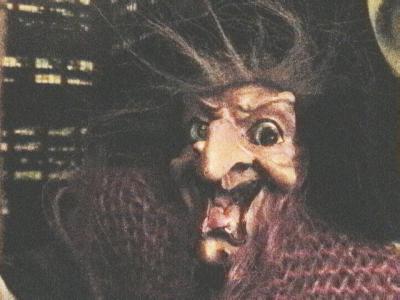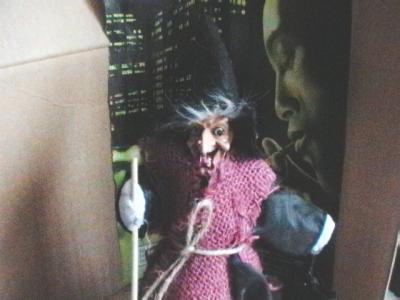Photo Background

While shooting pictures of this witch for Halloween, I needed a nice dark background to enhance the facial features of the witch, rather than drawing attention away from it. Background is very important when it comes to macro and close-up shots on flowers, miniatures, or other small items. Unlike a large landmark, where its environment could be its background, a small subject will generally be out of place in a home, office, or studio environment. The good news is that, since these subjects are small, backgrounds can be easily found in the existing environment.
For this witch picture, it took me only a few minutes to find a suitable backdrop in the latest copy of Maxim (or maybe it was Stuff magazine) that was lying around in my home. I already had nice cardboard box, cut up on two sides, to support the background. For the witch, I choose a picture with nice office building windows on a black background. The black background keeps the focus on the witch's face. The blurred office windows are subtle enough that they keep the background from being boring, yet does not intrude on the overall picture.

On the other hand, for shooting flower photos, outdoor pictures will make a more suitable background than office building windows. A magazine such as the Outdoor Photographer might suit that need better. Sometimes, you may have shot a nice photograph that can be used as background. Either use a print of your picture or position the subject in front of a computer monitor to create this environmental illusion. If you use the monitor idea, just make sure the subject is well lit from the front to counter the light from the monitor; unless, of course, you want to create a silhouette.
An 8.5" x 11" sheet of white paper works wonderfully for a simple white background. The same sheet of paper can be turned into any color with any color marker. An uneven coating of marker ink, or even hastily colored area, may yield an interesting blurred backdrop. Try mixing different color markers for even more fascinating results.
Assuming the focus is on the subject, changing the distance of the background from the subject changes the extent of the blurring effect on the background. Place the subject closer to the background renders a sharper background. Place the subject further away creates the opposite effect. Lens aperture can also be used to control the blur effect. A larger aperture (lower f-number) creates a shallow depth-of-field, therefore causes more blurring on the background than a smaller aperture (higher f-number).
Keep in mind that if you use someone else's picture in the background, your artwork may become a derived art based on the copyright law. Whether your artwork becomes a derived art depends on a number of criteria; it would be wise to seek legal console on this issue. It is legal for you to use your derived art for personal purpose and for editorial purpose. But you won't be able to sell your artwork or use it for advertising without first obtaining legal permission from the original artist. Copyright law changes over time and this article does not attempt to cover every aspect. Please consult with the local copyright office and/or an intellectual property lawyer.
Related Links
Discussion
Latest Discussion
All Discussions

